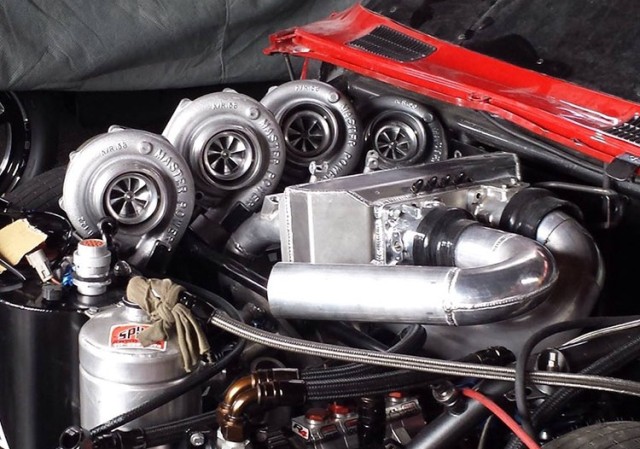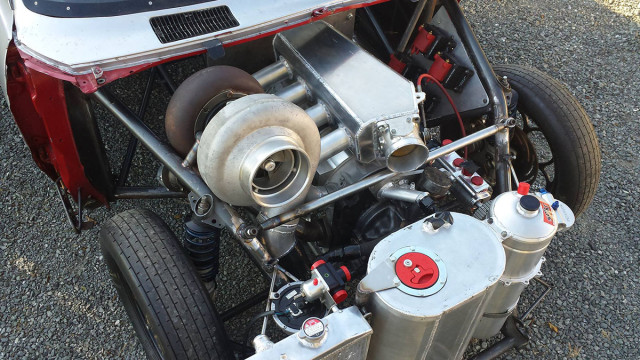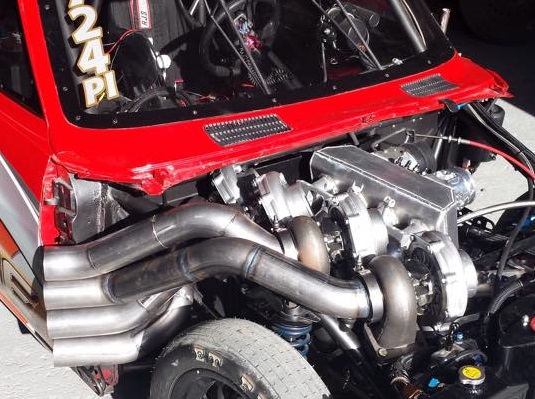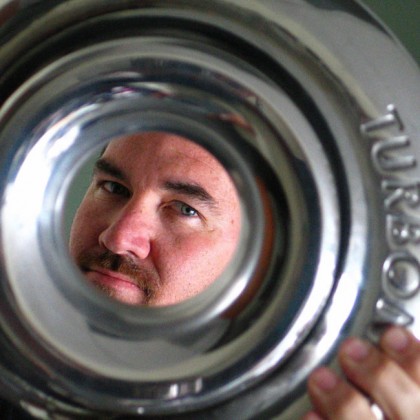 The brothers Curran aspire for a Zen-like balance in their lives. How do we know? …because 4-turbo, 4-rotor RX-2. Curran Brothers Racing in New Zealand are all about the Wankel rotary and have been deep into the import drag scene for decades. This 1971 Mazda RX-2 was pretty much built in-house at CBR and it’s wicked fast.
The brothers Curran aspire for a Zen-like balance in their lives. How do we know? …because 4-turbo, 4-rotor RX-2. Curran Brothers Racing in New Zealand are all about the Wankel rotary and have been deep into the import drag scene for decades. This 1971 Mazda RX-2 was pretty much built in-house at CBR and it’s wicked fast.
The car has been torn down and built up many, many times. And with each iteration it has seen a different number/configuration of turbos. It has also gotten faster each step of the way.
 The RX-2 was first built with a twin-turbo, two-rotor 13B under the hood. Then the brothers stepped into a wild three-rotor peripheral-ported 20B. In this configuration they ran both a twin-turbo and triple-turbo setup. One of the driving forces behind each advancement was to push the envelope from a reliability standpoint. Critics always point to the rotary engine’s frailty in big-boost, big-power situations, and Brent Curran is out to show them the light and illustrate you can have a bulletproof six-second rotary engine.
The RX-2 was first built with a twin-turbo, two-rotor 13B under the hood. Then the brothers stepped into a wild three-rotor peripheral-ported 20B. In this configuration they ran both a twin-turbo and triple-turbo setup. One of the driving forces behind each advancement was to push the envelope from a reliability standpoint. Critics always point to the rotary engine’s frailty in big-boost, big-power situations, and Brent Curran is out to show them the light and illustrate you can have a bulletproof six-second rotary engine.
The 20B generated around 1,300+ horsepower. And it proved long lasting as the weak line in the chain was the gearbox. So a Lenco CS3 air-shifted five-speed transmission was added to the mix. Fast forward to 2013 and the Curran Brothers dropped another paradigm shift on the RX. They added a another rotor to the equation, building a peripheral-ported four-rotor engine in hopes of producing 1,500 ponies.
 The 26B was pressurized with a huge single 106mm GT60 turbocharger and at 30-32 psi of boost rung the bell at 1,600 horsepower. New power level, new transmission. The Lenco was ditched in favor of a built Powerglide two-speed automatic. The Mazda screamed to a best of 6.89 at 203 mph and they all lived happily ever after… not quite. Breaking the six second barrier was a goal but not the end of the line for these New Zealanders.
The 26B was pressurized with a huge single 106mm GT60 turbocharger and at 30-32 psi of boost rung the bell at 1,600 horsepower. New power level, new transmission. The Lenco was ditched in favor of a built Powerglide two-speed automatic. The Mazda screamed to a best of 6.89 at 203 mph and they all lived happily ever after… not quite. Breaking the six second barrier was a goal but not the end of the line for these New Zealanders.
The Curran Bothers recently revealed via Facebook post that they were going to a four-turbo setup saying, “Let’s face it, going by previous setups this was always going to happen, whether I thought it or not,” said Brent. “I have no doubt this setup will support the 40 psi boost that I require. We proved that with our old three-rotor setup which got us into the sixes with 40 psi on the 20B, 28 psi got us just over 200 mph and sixes with the 4 rotor, so let’s hope the four-rotor with 40 psi will give me an animal to drive.”
 “We went this way for a few reasons.., done it on the two- and three-rotor so it’d be rude not to do it on the big block. Quad turbos work well, would have liked to go twin setup but simply can’t afford the turbos needed to do the job. It should be easy to tune each rotor, easy to make small changes to the turbo wheels, easy to get parts for servicing, and simply when spec’d correctly they are very hard to beat.”
“We went this way for a few reasons.., done it on the two- and three-rotor so it’d be rude not to do it on the big block. Quad turbos work well, would have liked to go twin setup but simply can’t afford the turbos needed to do the job. It should be easy to tune each rotor, easy to make small changes to the turbo wheels, easy to get parts for servicing, and simply when spec’d correctly they are very hard to beat.”
We will keep our eyes on the interwebs to see if the car hits the track. In the meantime checkout this blast from the past video of the CBR RX-2. The footage is vertical and all wrong… but the soundtrack four screaming rotors and it is all right.
Full Tube Chassis 4 Rotor Turbo RX2
Best ET: 6.89 @ 203 MPH (as Single Turbo)
Class: Pro Import
Car: 1971 Mazda RX2
Chassis: Full chrome moly
Weight: 1080 kgs
Engine: 4 rotor Peripheral Port Rotary
Turbo: 4 Master Power turbos
Induction: Custom CBR
Gearbox: Two Speed Powerglide
Torque convereter: 10″
Diff: 9″ sheet metal, Strange 40 spline axles, Mark Williams head
Fuels/ Oils: Methanol, Castrol R30 premix
Brakes: Wilwood/ Strange
Suspension/ Steering: Strange struts, Koni shocks, 4 link
Wheels/ Tires: 15 x 14 Max wheels (rear) 15 x 3 Weld wheels (front) 32 x 14.5 Mickey Thompson rear slicks



















